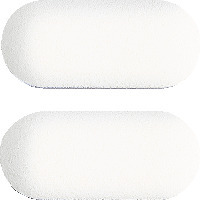What is in this leaflet
Read this leaflet carefully before taking your medicine.
This leaflet answers some common questions about tramadol. It does not contain all the available information. It does not take the place of talking to your doctor or pharmacist.
The information in this leaflet was last updated on the date listed on the last page. More recent information on this medicine may be available.
Ask your doctor or pharmacist:
- if there is anything you do not understand in this leaflet
- if you are worried about taking your medicine, or
- to obtain the most up-to-date information.
All medicines have risks and benefits. Your doctor has weighed the risks of you using this medicine against the benefits they expect it will have for you.
Pharmaceutical companies cannot give you medical advice or an individual diagnosis.
Keep this leaflet with your medicine. You may want to read it again.
What this medicine is used for
The name of your medicine is Terry White Chemists Tramadol SR. It contains the active ingredient, tramadol (as tramadol hydrochloride).
It is used to relieve moderate to severe pain.
Ask your doctor if you have any questions about why this medicine has been prescribed for you. Your doctor may have prescribed this medicine for another reason.
This medicine is available only with a doctor's prescription.
How it works
It belongs to the group of medicines called analgesics (pain relievers). The tablets are designed to release the active ingredient for pain relief gradually over several hours.
Use in children
There is not enough information to recommend the use of this medicine in children under 12 years of age.
Use in the elderly
Patients over 75 years may need a reduced daily dose of this medicine compared to younger adults.
Before you take this medicine
When you must not take it
Do not take this medicine if:
- you have recently taken large amounts of alcohol or other substances which can affect your level of consciousness
- you are taking a medicine containing a "monoamine oxidase inhibitor" also known as MAOI, or have taken any within the past two weeks. Examples of MAOIs include selegiline, phenelzine, tranylcypromine, linezolid, methylene blue and moclobemide
- you require treatment for withdrawal from narcotics
- you suffer from epilepsy which is not controlled properly by any therapy
- it has passed the expiry date (EXP) printed on the pack.
- the packaging is torn, shows signs of tampering or it does not look quite right.
- you have an allergy to any other medicines known as opioid analgesics, e.g. morphine or codeine
- you have had an allergic reaction to tramadol or any of the ingredients listed at the end of this leaflet.
Symptoms of an allergic reaction may include: cough, shortness of breath, wheezing or difficulty breathing; swelling of the face, lips, tongue, throat or other parts of the body, rash, itching or hives on the skin fainting or hayfever-like symptoms.
Before you start to take it
Before you start taking this medicine, tell your doctor if:
- You have allergies or sensitivities to:
- opioids (morphine-like medicines)
- any other medicines
- any other substances, such as foods, preservatives or dyes.
- You have or have had any medical conditions, especially the following:
- any disorder of the kidney, liver or pancreas, including any related to alcohol intake - for example, cirrhosis of the liver
- stomach problems
- fits or convulsions
- lung or breathing problems
- a severe headache, or you are not fully conscious, have had a head injury or have been told that you are in shock or have raised intracranial pressure
- any drug or alcohol dependence.
- You are currently pregnant or breastfeeding or you plan to become pregnant or breast feed.
This medicine is not recommended for use during pregnancy or labour or whilst breast feeding. Talk to your doctor about the risks and benefits of using this medicine during pregnancy or labour or when breast feeding.
- You have recently been vaccinated or plan to get a vaccination.
- You are planning to have surgery.
- You are currently receiving or are planning to receive dental treatment.
- You are taking or are planning to take any other medicines.
This includes vitamins and supplements that are available from your pharmacy, supermarket or health food shop.
Some medicines may interact with tramadol. These include:
- medicines used to prevent blood clots, such as warfarin and coumarin
- buprenorphine, morphine, pethidine and pentazocine, other similar medicines used to treat pain
- Monoamine Oxidase Inhibitors, used to treat depression or Parkinson's disease (also tell your doctor if you have taken any of these within the last 14 days)
- carbamazepine, used to treat epilepsy (fits) and also bipolar disorder
- sedatives and tranquilisers, used to calm you down and/or help you sleep
- quinidine, used to modify heart rate and rhythm
- antipsychotics and antidepressants used for treating disorders of the brain which affect the way people think, feel or act
- phenothiazines, used as antipsychotics, and also to help stop vomiting
- ketoconazole, an antifungal medicine
- erythromycin, an antibiotic
- ondansetron, a medicine used before or after operations to stop or prevent vomiting
- anaesthetics, used during operations
- any other medicine which may make you sleepy.
If you are taking any of these you may need a different dose or you may need to take different medicines.
Other medicines not listed above may also interact with tramadol.
You must also be careful if you drink alcohol whilst taking this medicine.
How to take this medicine
Follow carefully all directions given to you by your doctor or pharmacist. Their instructions may be different to the information in this leaflet.
How much to take
Your doctor or pharmacist will tell you how much of this medicine you should take. This will depend on your condition and whether you are taking any other medicines.
The recommended dosage is either:
- one or two 100 mg tablet(s) twice a day (morning and evening)- maximum 4 tablets per day
or
- one 150 mg or 200 mg tablet twice a day (morning and evening) - maximum 2 tablets per day.
For some people the starting dose may be lower.
If you are over 75 you may be prescribed a lower dose, with a maximum of 300 mg in total per day.
You may also be prescribed a lower dose if you have liver problems.
If you have kidney problems your doctor may recommend a bigger time interval between doses.
If your liver or kidney problems are severe you should not take Tramadol SR.
How to take it
Swallow the tablets whole with water.
Do NOT chew, crush or dissolve them.
This will release all the active ingredient for pain relief quite quickly. Side effects may then occur.
When to take it
Take this medicine at the same time each day. Taking it at the same time each day will have the best effect and will also help you remember when to take it.
It does not matter if you take it before, with or after food.
How long to take it for
Continue taking your medicine for as long as your doctor tells you.
- if you feel that you do not need as much tramadol as your doctor has prescribed for you, talk to your doctor
- tell your doctor if your pain is not helped or gets worse. Do not take increased amounts or extra doses of tramadol unless your doctor advises you to
If you take this medicine for more than a few months your doctor will monitor you regularly.
Make sure you have enough to last over weekends and holidays.
If you forget to take it
If you forget to take one dose, take the dose when you remember. The following dose should be taken after twelve hours, or as prescribed by your doctor.
Do not take a double dose to make up for missed doses.
This may increase the chance of unwanted side effects.
If you have trouble remembering to take your medicine, ask your pharmacist for some hints.
If you take too much (overdose)
If you think that you or anyone else may have taken too much of this medicine, immediately telephone your doctor or the Poisons Information Centre (Tel: 13 11 26 in Australia) for advice. Alternatively go to the Accident and Emergency Department at your nearest hospital.
Do this even if there are no signs of discomfort or poisoning. You may need urgent medical attention.
If you take too much tramadol, you may have constricted pupils, go into shock, vomit, have problems breathing, become unconscious, and/or suffer fits (convulsions).
While you are taking this medicine
Things you must do
Tell your doctor that you are taking this medicine if:
- you are about to be started on any new medicine
- you plan to have any vaccinations or immunisations
- you become pregnant or plan to breastfeed (tell your doctor immediately)
- you are about to have any blood tests
- you are going to have surgery.
Your doctor may occasionally do tests to make sure the medicine is working and to prevent side effects. Go to your doctor regularly for a check-up.
Tell any other doctors, dentists, and pharmacists who are treating you that you are taking tramadol.
Things you must not do
Do not:
- give this medicine to anyone else, even if their symptoms seem similar to yours
- take your medicine to treat any other complaints unless your doctor or pharmacist tells you to
- stop taking your medicine, or change the dosage, without checking with your doctor.
Things to be careful of
Avoid or be especially careful driving or operating machinery or doing anything else that requires concentration and good reflexes; tramadol can cause drowsiness, dizziness or fatigue in some people. If any of these occur, do not drive, operate machinery or do anything else that could be dangerous.
Avoid drinking large quantities of alcohol, as this may make you feel even more sleepy, and may also increase the chance of liver problems.
Possible side effects
Tell your doctor or pharmacist as soon as possible if you do not feel well while you are taking tramadol or if you have any questions or concerns.
Do not be alarmed by the following lists of side effects. You may not experience any of them. All medicines can have side effects. Sometimes they are serious but most of the time they are not.
Tell your doctor or pharmacist if you notice any of the following and they worry you.
This list includes the more common side effects. Mostly, these are mild:
- dizziness
- feeling sleepy, tired or weak
- headache
- constipation, diarrhoea
- wind, indigestion, feeling or being sick
- sweating
- dry mouth
- flushing
- dilated pupils
- feeling faint or dizzy when standing up (due to lowered blood pressure)
- changes in appetite
Tell your doctor as soon as possible if you notice any of the following.
These may be serious side effects. You may need medical attention. Most of these side effects are rare.
- mild skin reactions or itching
- sudden increase or decrease in blood pressure
- muscle weakness, feeling uncoordinated
- trembling, twitching
- tingling sensation (pins and needles),
- problems speaking
- feeling "high"
- hallucinations (seeing, feeling or hearing things that are not there)
- feeling spaced out, confused or unable to make proper decisions
- problems sleeping, nightmares
- blurred vision
- difficulty or pain when passing urine, or passing less urine than usual
- Serotonin Syndrome: signs of this vary and are not specific. They may include sudden fever, sweating, confusion, hallucinations, loss of coordination, agitation, diarrhoea, muscle twitching, sudden jerking movements, overactive reflexes, difficulty with walking and balance, fast heart beat, sweating, muscle spasm, racing thoughts, restlessness. Serotonin Syndrome may result from interaction of tramadol with other medicines which increase serotonin effects, for example, the SSRI antidepressants.
If you experience any of the following, stop taking your medicine and contact your doctor immediately or go to the Accident and Emergency department at your nearest hospital.
These are very serious side effects and are usually very rare. You may need urgent medical attention or hospitalisation.
- chest tightness, wheezing or pain in the chest
- faster or slower heart rate, palpitations, fainting or collapse
- convulsions (fits)
- problems breathing or asthma getting worse
Other side effects not listed above may occur in some patients.
Allergic reactions
If you think you are having an allergic reaction to tramadol, stop taking this medicine and tell your doctor immediately or go to the Accident and Emergency department at your nearest hospital.
Symptoms of an allergic reaction may include some or all of the following:
- cough, shortness of breath, wheezing or difficulty breathing
- swelling of the face, lips, tongue, throat or other parts of the body
- rash, itching or hives on the skin
- fainting
- hayfever-like symptoms
Withdrawal Symptoms
If you are taking this medicine for a long while, your body may become used to tramadol and mild withdrawal symptoms may occur if you suddenly stop taking it. For example, you may become agitated, shaky, hyperactive, anxious, or nervous, have problems sleeping, and/or suffer fever, muscle pain or chills.
Very rarely, people have had panic attacks, severe anxiety, hallucinations, tingling sensation (pins and needles), ringing in the ears, confusion, delusions, paranoia, or a feeling of being spaced out or apart from everything.
Storage and disposal
Storage
Keep your medicine in its original packaging until it is time to take it.
If you take your medicine out of its original packaging it may not keep well.
Keep your medicine in a cool dry place where the temperature will stay below 25°C.
Do not store your medicine, or any other medicine, in the bathroom or near a sink. Do not leave it on a window sill or in the car.
Heat and dampness can destroy some medicines.
Keep it where children cannot reach it.
A locked cupboard at least one-and-a-half metres above the ground is a good place to store medicines.
Disposal
If your doctor or pharmacist tells you to stop taking this medicine or it has passed its expiry date, your pharmacist can dispose of the remaining medicine safely.
Product description
What Terry White Chemists Tramadol SR looks like
100 mg tablets
Off-white, round, biconvex tablets
150 mg tablets
Off-white, capsule-shaped tablets
200 mg tablets
Off-white, capsule-shaped tablets
Contained in blister packs in cartons of 20 tablets.
* Not all strengths, pack types and/or pack sizes may be available.
Ingredients
Each tablet contains 100 mg, 150 mg or 200 mg of tramadol as the active ingredient.
It also contains the following inactive ingredients:
- Calcium hydrogen phosphate
- Hydroxypropylcellulose
- Colloidal anhydrous silica
- Magnesium stearate
This medicine is gluten-free, lactose-free, sucrose-free, tartrazine-free and free of other azo dyes.
Australian Registration Numbers
Terry White Chemists Tramadol SR 100mg tablets
Blister packs
AUST R 154401.
Terry White Chemists Tramadol SR 150mg tablets
Blister packs
AUST R 154402.
Terry White Chemists Tramadol SR 200mg tablets
Blister packs
AUST R 154403.
Sponsor
Southern Cross Pharma Pty Ltd
56 Illabunda Drive
Malua Bay, NSW, 2536
Distributor
Symbion Pharmacy Services Pty Ltd
48-58 Overseas Drive
Noble Park North, VIC 3174
Australia
Terry White Chemists is a registered trade mark of Symbion Pharmacy Services Pty Ltd.
This leaflet was last updated in:
November 2010.





